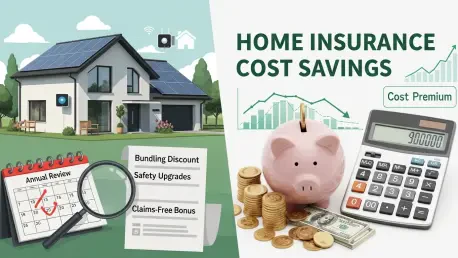Imagine opening an email from your home insurance provider only to discover that the annual premium to protect your property has nearly doubled, jumping from a manageable $5,600 to a staggering $9,800, significantly inflating monthly mortgage payments by hundreds of dollars. This scenario is becoming all too common for homeowners across the United States, where skyrocketing insurance costs are driven by escalating claim amounts and higher replacement expenses. In many cases, policyholders are also facing unexpected changes, such as deductibles shifting from a flat fee to a percentage of dwelling coverage, adding thousands to out-of-pocket costs during claims. With such dramatic increases, staying with a single insurer for years without exploring alternatives is no longer a viable option. Instead, a growing number of individuals are finding relief by comparing rates and switching providers, a strategy that proves essential in navigating the challenging landscape of today’s home insurance market.
1. Understanding the Surge in Home Insurance Rates
The rapid rise in home insurance premiums is a pressing concern for property owners nationwide, with rates climbing by an alarming 40.4% between 2019 and 2024, as reported by recent industry analyses. In just the last few years, annual increases have intensified, with hikes of 5.4% in 2022, 11.0% in 2023, and 11.4% in 2024, bringing the average yearly cost to $2,801 across the country. Certain states have borne the brunt of these spikes, with Montana and Nebraska experiencing the highest jumps at 22.1% in 2024, closely followed by Minnesota and Washington at 19.5%. These escalating costs are fueled by a combination of factors, including soaring reconstruction expenses due to supply chain disruptions, labor shortages, and potential tariffs on building materials. Additionally, severe weather events like wind and hail, which accounted for 42.5% of property damage losses in 2023, along with wildfire risks in states like California and Colorado, are pushing insurers to adjust premiums to cover heightened risks.
Beyond environmental challenges, insurance providers rely on sophisticated catastrophe models that predict an increase in the frequency and severity of storms, further influencing rate adjustments. Premiums are also tailored based on specific factors such as a home’s location, age, condition, and the policyholder’s claims history and personal characteristics like credit score. For many, these adjustments mean not only higher costs but also policy changes, such as increased deductibles for specific damages like wind or hail. As a result, homeowners in high-risk areas often face the steepest increases, making it critical to stay informed about regional trends and the underlying causes of these financial burdens. The reality is that the home insurance landscape has shifted dramatically, and understanding these drivers is the first step toward managing the impact on household budgets. Without proactive measures, many risk being priced out of adequate coverage, underscoring the urgency of exploring cost-saving options.
2. Impact on Homebuyers and Financial Planning
For prospective homebuyers, the surge in insurance premiums is reshaping the path to homeownership, often complicating affordability calculations and forcing a reevaluation of financial planning. Mortgage consultants have observed a significant shift in how insurance costs are factored into the buying process. Once considered a minor detail to address just before closing, these expenses are now a critical component of budget discussions. For individuals with tight debt-to-income ratios, an unexpectedly high insurance quote can derail mortgage approval if it pushes their financial metrics beyond acceptable limits. This new reality forces buyers to account for insurance early in their planning, ensuring they aren’t caught off guard by costs that could jeopardize their ability to secure a loan. The ripple effect is clear: what was once an afterthought has become a pivotal factor in determining whether a dream home is within reach.
Lenders, too, are adapting to this trend by emphasizing the importance of accurate cost projections during initial consultations. As premiums continue to climb, driven by regional risks and broader economic pressures, the conversation around homeownership is evolving to prioritize comprehensive financial preparedness. This means potential buyers must research insurance rates specific to their target areas long before making an offer, as costs can vary widely even within the same city due to localized risks like flooding or wildfires. The stakes are high, as failing to anticipate these expenses can lead to significant setbacks in the home-buying journey. For existing homeowners, the challenge is no less daunting, as renewal notices often bring unwelcome surprises in the form of steep rate hikes. Addressing these costs head-on, whether as a buyer or current owner, is essential to maintaining financial stability in an increasingly unpredictable market.
3. Start Your Insurance Search Early
One of the most effective strategies for managing rising home insurance costs is to begin the search for coverage as early as possible, especially for those in the process of buying a home. This means initiating the hunt for quotes immediately after mortgage preapproval, rather than delaying until the closing date looms. Taking this proactive approach allows buyers to integrate accurate insurance costs into their overall budget, preventing last-minute surprises that could disrupt their plans. It also provides the flexibility to adjust the scope of their home search if premiums in certain areas prove unaffordable. Early research can reveal significant variations in rates, enabling more informed decisions about where to purchase and what level of coverage is feasible within financial constraints.
For current homeowners, timing is equally critical when it comes to reviewing and potentially switching insurance policies. Renewal notices typically arrive a few weeks before the existing coverage expires, offering a window to evaluate the proposed rates and explore alternatives if they seem excessive. Comparing options through direct contact with major carriers, utilizing online marketplaces for quotes, or engaging an independent broker can uncover more competitive offers. This process requires diligence, as waiting until the last moment may limit choices and force acceptance of unfavorable terms. By starting early, homeowners gain the advantage of time to thoroughly assess policies, ensuring they secure coverage that aligns with both their needs and budget. This step is a cornerstone of navigating the current climate of escalating premiums, where preparation can make a substantial difference in overall costs.
4. Know Your Coverage Needs Thoroughly
Understanding the specifics of what a home insurance policy covers—and what it excludes—is fundamental to avoiding unexpected financial burdens, especially since many homeowners are unaware of the limitations. Standard policies generally protect the structure of a home, personal belongings, and provide liability coverage, but many risks fall outside this scope. Events such as earthquakes, sinkholes, floods, and normal wear and tear often require separate policies or riders, which can come as a surprise to the unprepared. Notably, a significant misconception persists, with 63% of homeowners incorrectly assuming flood insurance is included in their standard policy, according to recent surveys. For properties in federally designated high-risk flood zones, lenders may mandate additional coverage through programs like FEMA, making it essential to clarify these requirements upfront.
To ensure adequate protection, homeowners should familiarize themselves with the specific risks prevalent in their area, whether it’s severe weather, geological hazards, or other local concerns, and take proactive steps to address them. Reviewing the declaration page of a policy is a critical step in identifying gaps in coverage that might necessitate additional purchases. This detailed examination helps in tailoring insurance to match actual needs, preventing overpayment for unnecessary features or underinsurance against significant threats. Consulting with providers to address any uncertainties about terms or exclusions can further safeguard against surprises during a claim. Given the diversity of policies available, taking the time to dissect coverage details is not just prudent but necessary in a market where costs are rising and risks are evolving. This knowledge empowers property owners to make informed choices, balancing protection with affordability.
5. Compare Multiple Insurers Regularly
Remaining with a single insurance provider for an extended period can lead to missed opportunities for savings, making it vital to compare offerings from multiple carriers at least every one to two years. Loyalty to one company might seem convenient, but it often results in paying higher premiums than necessary, especially as market rates and risk assessments shift. Actively seeking quotes from various insurers reveals the range of pricing and coverage options available, potentially uncovering more favorable terms. This practice ensures that policyholders are not locked into outdated or overpriced plans, particularly in a climate where rate increases are commonplace due to heightened environmental and economic pressures.
When evaluating quotes, it’s crucial to ensure consistency in key coverage areas such as dwelling protection, personal property, other structures, deductibles, personal liability, and medical payments. Disparities in these elements can skew comparisons, so aligning them with specific needs is essential for an accurate assessment. Additionally, attention should be paid to policy exclusions that might require supplementary coverage, such as for floods or earthquakes, which are often not included in standard plans. Insurers may also adjust rates based on their exposure in certain regions, sometimes raising prices to deter new policies in high-risk zones. By regularly shopping around, homeowners can capitalize on competitive pricing from companies eager to balance their portfolios, securing better deals while maintaining adequate protection.
6. Explore Discounts and Savings Opportunities
Uncovering potential discounts is a powerful way to offset the burden of rising home insurance premiums, and many insurers offer savings for specific actions or upgrades. Home improvements, such as installing impact-resistant roofing or professionally monitored security systems, can often qualify for reduced rates, as they lower the likelihood of claims. Similarly, updating critical systems like plumbing, electrical, or HVAC components can demonstrate a commitment to property maintenance, potentially lowering costs. Smart home technologies, including leak detectors or automatic water shut-off valves, are also increasingly recognized by carriers as risk-reducing measures worthy of discounts. These investments not only enhance safety but can also yield long-term financial benefits through lower premiums.
Another avenue for savings lies in bundling policies, such as combining home and auto insurance with the same provider, which often results in significant reductions. Homeowners should actively inquire about all available discounts, as these are not always automatically applied or advertised. Engaging in a conversation with an insurer or broker can reveal lesser-known opportunities tailored to specific circumstances or regional offerings. While the initial cost of upgrades or bundling might seem daunting, the cumulative savings on annual premiums can make a substantial difference, especially in an era of escalating rates. Taking advantage of these incentives requires proactive communication and a willingness to invest in preventive measures, but the payoff can be a more manageable insurance expense aligned with household budgets.
7. Implement Preventive Measures for Risk Reduction
Taking proactive steps to minimize property damage risks not only enhances safety but can also lead to lower insurance premiums, as many carriers reward mitigation efforts. In areas prone to wildfires, maintaining fire-resistant landscaping, keeping gutters clear of debris, and using appropriate roofing materials can significantly reduce vulnerability. These actions demonstrate to insurers a commitment to risk management, often resulting in more favorable pricing or policy terms. Some companies even mandate such measures as a condition of coverage, particularly in high-risk zones where the potential for catastrophic loss is elevated. Adopting these practices is both a protective and cost-effective strategy for homeowners facing environmental threats.
For all property owners, regardless of location, consistent maintenance is key to preventing costly damages that could trigger claims and subsequent rate hikes, ensuring long-term protection. Regular seasonal upkeep, timely servicing of critical systems like heating or cooling, and prompt repairs to address minor issues before they escalate are essential practices. These efforts signal to insurers that the home is well-cared for, potentially lowering perceived risk and associated costs. While the upfront time and expense of mitigation can seem burdensome, the long-term benefits include not only reduced premiums but also greater peace of mind. In a market where insurance expenses are climbing, such preventive actions serve as a practical means to control both financial and physical risks, ensuring homes remain protected without breaking the bank.
8. Be Strategic About Property Location Choices
Choosing a location wisely is a critical consideration for managing insurance costs, especially for new buyers navigating the home purchase process, as it can significantly impact the overall expenses. Investigating whether a potential area falls within a FEMA-designated high-risk flood zone or is prone to other hazards like wind or fire can reveal significant cost implications. Even within the same city, neighborhoods can vary widely in terms of risk exposure, leading to substantial differences in premiums. Consulting with an insurance broker to assess regional rate trends before committing to a purchase can prevent unexpected financial strain. This due diligence ensures that buyers are fully aware of the long-term costs associated with a property beyond just the purchase price.
For those already settled in high-risk areas, understanding local vulnerabilities remains important when considering policy renewals or property upgrades, as these factors can significantly impact costs and coverage options. Areas with elevated risks often face steeper rate increases as insurers adjust to cover potential losses from natural disasters or other threats. While relocating may not always be feasible, being informed about these factors can guide decisions on additional coverage or mitigation efforts to offset costs. Location plays an undeniable role in shaping insurance expenses, and overlooking this aspect can lead to budgets stretched thin by premiums that could have been anticipated. Strategic planning around where to buy or how to protect an existing home is a vital step in maintaining affordability amid a challenging insurance landscape.
9. Review Coverage Annually for Adjustments
Conducting an annual review of home insurance coverage is a prudent habit, especially at renewal time or following significant life changes that could alter risk profiles. Events such as home renovations, the addition of family members, or the installation of high-liability features like pools or trampolines can necessitate updates to a policy to ensure adequate protection. Similarly, experiencing major weather events that heighten local risks or paying off a mortgage—which removes lender-mandated coverage requirements—may prompt a reassessment of needs. Regularly revisiting these details helps avoid gaps in coverage that could prove costly during a claim, while also preventing overpayment for unnecessary protections.
Beyond routine renewals, engaging with an insurance provider to clarify any ambiguities in policy terms is essential, as offerings can differ widely between companies. This dialogue ensures that coverage aligns with current circumstances, whether it’s adjusting for a new home office used for business or accounting for increased property value after upgrades. The dynamic nature of both personal situations and the broader insurance market demands this ongoing attention to detail. Annual reviews serve as a safeguard against being underinsured or overburdened by premiums, providing an opportunity to tailor policies to evolving needs. Staying proactive in this way is a key component of managing costs effectively in an environment where rates and risks are in constant flux.
10. Navigating Future Challenges with Smart Strategies
Reflecting on the trajectory of home insurance costs, it became evident that proactive measures were indispensable for homeowners grappling with unprecedented rate hikes driven by economic and environmental shifts. The sharp increases witnessed over recent years underscored the necessity of regularly shopping around for competitive policies to mitigate financial strain. Homeowners who took the initiative to compare insurers, seek discounts, and implement risk-reducing measures often found substantial savings while maintaining essential coverage. These actions proved critical in an era where staying with a single provider without reassessment frequently led to overpaying for protection.
Looking ahead, the focus should shift toward sustained vigilance and strategic planning to address ongoing challenges in the insurance market. Homeowners are encouraged to integrate annual policy reviews into their financial routines, ensuring coverage evolves with personal and regional changes. Leveraging early research, understanding policy specifics, and prioritizing preventive maintenance can further fortify households against future premium spikes. As the landscape of risks and costs continues to transform, adopting these smart strategies offers a pathway to balance affordability with security, empowering property owners to safeguard their investments without compromising their budgets.









